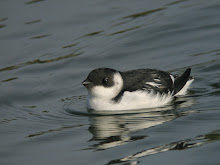
Bird Watching magazine editor Kevin Wilmot adopts the handheld digiscoping pose for the Canon PowerShot A640.
I've recently had quite a few calls asking how I go about digiscoping with my Canon PowerShot A640 (which I use with a Kowa TSN-823 scope and 32xW eyepiece)
In the
Digiscoping Made Easy DVD I used a PowerShot A95 with a sort of metal tube (a Lensmate) clipped onto a bayonet fitting on the camera. The tube slides neatly into the scope eyepiece, centring the camera and holding it just the right distance from the eyepiece – there was no vignetting at any magnification and it worked beautifully.
I upgraded to the A640 because it has twice the megapixels (10 rather than 5) and the macro is amazing (with an incredible close-focus distance of about 1cm).
The downside is that there isn't a convenient Lensmate-equivalent to connect for digiscoping.
Fear not, though, there is an easy solution – plastic tubing.
Below is the step-by-step guide to how I do my digiscoping. To align the camera with the scope eyepiece, I simply use a plastic ring cut from some plastic piping from a DIY store.

I use one of two rings. The deeper one lifts the camera slightly further away from the eypiece, to stop vignetting at the lowest camera magnifcation. The thinner one is for when the camera is slightly zoomed in. (I worked out the distance by measuring how far back I needed the camera until the vignetting disappeared).

If I am going to be digiscoping all I do is whip out the relevant ring, comme ça...

...then I pop the ring in the scope's eyepiece.

So, it looks like this.

Then all I need to do is insert my camera's lens in the tube.

So, you end up with a set-up looking like this...

...or, if you like, this...

Then you snap away. Here, once more, is Kevin Wilmot impersonating my digiscoping technique beautifully...

















